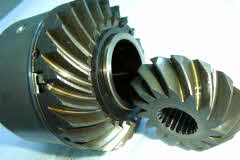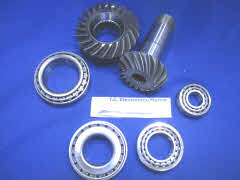|
Bevel Gears
Outboard Motor Corporation (OMC) engineered all of their stern drive models
to use bevel gears for power transference from engine to the propeller.
This was (and still is) the most efficient
design for marine outdrives and outboard lower units. The bevel gears are used when power is need to be transferred from the
drive gear to the driven gear; and are typically mounted on shafts at right angles (90 degrees) to each other but can also
be designed to function at various angles.
Fundamental design concepts of gear engineering are pitch angle and
surface; pitch surface of a bevel gear appears as a cone shape, and the pitch angle is the angle (degree) between the axis
of the gear and face of the pitch surface.
OMC gear sets are sold as sets and not as individual gears. The reason
for this is the meshing surface between two mating gears must be precise and within tolerances for applications; if one gear
is damaged, they must both be replaced.
Gear Ratio
The term gear ratio refers to the rotational angular speed (velocity) of the drive
gear (input) in relation to the driven gear (output).
For marine applications, the gear ratio can be identified
by either the number of teeth on pinion gear and matching driven gear or the ratio percentage from one gear to the other.
Each motor that powers the stern drive will have different horsepower and torque ratings; and these specifications must be
matched to the correct outdrive gear ratio to get the maximum power transfer from engine to propeller.
To calculate
the gear ratio, it is important to note which gear is the drive gear and which is the driven gear. Note the number of teeth
on the input drive gear and the number of teeth on the output driven gear.
The numerical ratio is calculated by
dividing the number of teeth on the meshed gear, or gear with the large number of teeth (output) by the number of teeth on
the input drive gear, or gear with smaller number of teeth (output # / input # = x).
A typical example would be
the lower unit gear set on an Cobra V6 and V8 models; the pinion gear (input) has 14 teeth, and the forward / reverse gears
(output) have 26 teeth. Based on the simple formula (26 / 14), this gives us a gear ratio of 1.85.
There are only
two different ratios for the 1982 – 1993 Cobra and 800 / 400 models; with a third ratio of 1.83 (22/12) available through
GLM Marine in their heavy duty gear sets for high powered V8 motors.
 The Stringer model - widely referred to as the Electric Shift model; was first produced in 1962. These models used were
produced until 1968, and in 1969 - with more powerful engine options available the lower unit was redesigned with gears to
meet the requirements of these higher horsepower motors. This second generation Stringer was manufactured until 1977 with
a lower unit ratio of 1.53 (23/15) for all 4 cylinder, V6 and V8 motors.
The upper gear case of the stern-drive
used a ratio of 1.25 (20/16) for the 120 horsepower 4 cylinder, 1.05 (19/20) ratio for the 140 horsepower 4 cylinder, 1.10
(21/19) for all 6 cylinder motors and 1.31 (21/16) for all V8 motors. In 1978, the upper ratio for both the 120 and 140 horsepower
motors was changed to 1.16 (21/18); and the lower unit was radically redesigned when the shifting system changed from the
electric clutch hub design to a mechanical / hydraulic assisted shift design.
This new lower unit, sometimes referred
to as the ‘Servo hydro shift’ was only produced for four years (1978-1981) until OMC engineers redesigned the
lower unit to use a direct mechanical shift system in 1982. The lower unit had a ratio of 1.85 (26/14) for inline 6, V6 and
V8 motors; and a ratio of 2.00 (26/13) for all 4 cylinder motors
 In 1986, when patent restrictions expired from Volvo, engineers completely redesigned their stern drives and began production
of the Cobra outdrive. These new models used a modern, u-joint drive shaft system which allowed for the outdrive to be used
when tilted up and turned to either port or starboard. At the time, Mercury Mercruiser and Volvo were already using these
designs in their line of stern drives.
The Cobra model continued to use the same gear ratio as the 1978 –
1985 Servo hydraulic and mechanical shift models in the lower unit; however the ratios in the upper unit for some motors changed
due to more efficient engine designs which allowed for higher output torque and horsepower, and the introduction (21/17) ratio.
Ratios for the 4 cylinders, 6 cylinder (V6) and small block V8’s remained the same. The 5.0L 302 Ford used
the same ratio as the 2.3L and 3.0L 4 cylinder engines.
Electronic fuel injection technology) new ratios were
added for new motors that were not previously available - the 5.0L Chevy 305, 5.8L 351 Ford (non carburetor E.F.I.) and the
7.5L 460 Ford V8’s used a 1.23. (21/17) ratio.
Ratios for the 4 cylinders, 6 cylinder (V6) and small block
V8 remained the same. The 5.0L 302 Ford used the same ratio as the 2.3L and 3.0L 4 cylinder engines.
Gear Material
Alloy Steel Although the Outboard Motor Corporation officially went out of
business in 1998 when Volvo purchased their manufacturing facility and rights - original parts are still widely available
for the OMC stern drives.
With manufacturing facilities located in the United States, Canada, Mexico, Finland and
Austria; Bombardier Recreational Products (BRP) continues to manufacture and produce OEM gear sets for the Cobra and 800 models.
Steel is an alloy of iron and carbon, with alloy steels using additional elements to modify the composition of
the steel. The steel used in the BRP gear sets are forged from 8620 (OEM # 986980 for 1986 – 1993 models); and some
aftermarket companies, such as GLM Marine, use a proprietary composition of higher alloy forged steel on some of their heavy
duty sets.
|